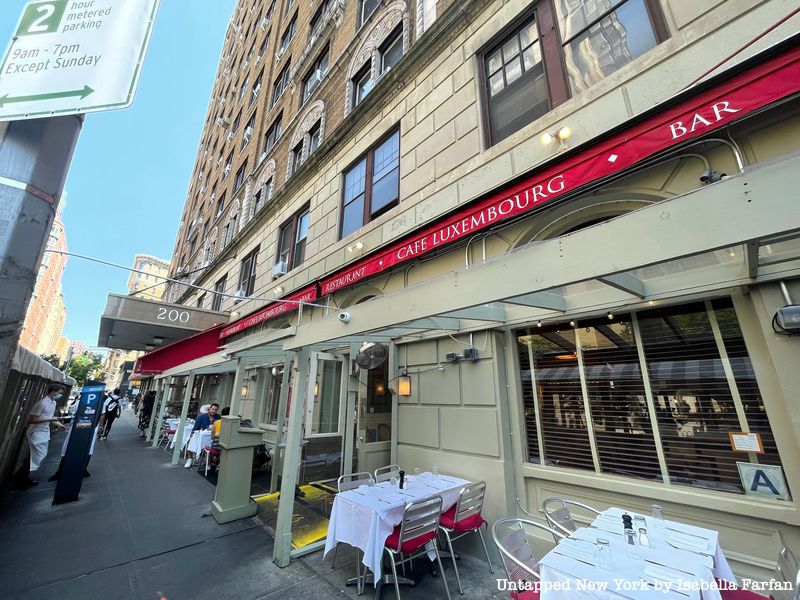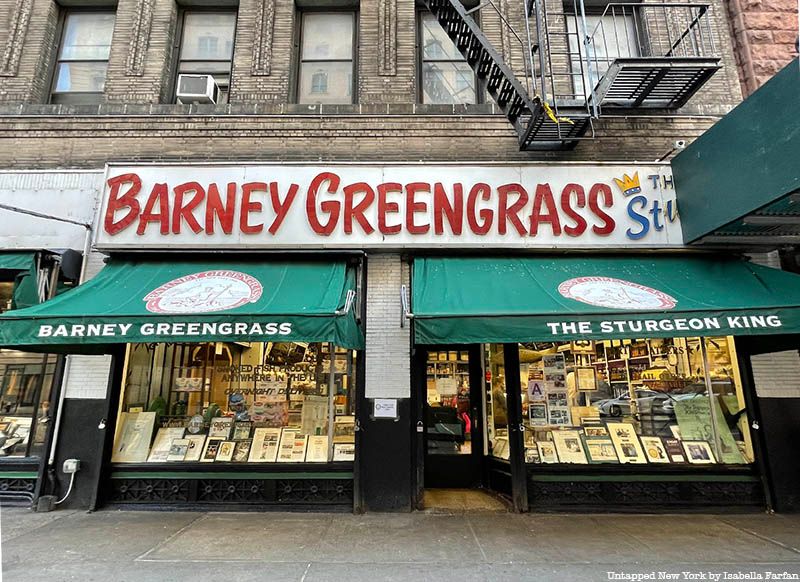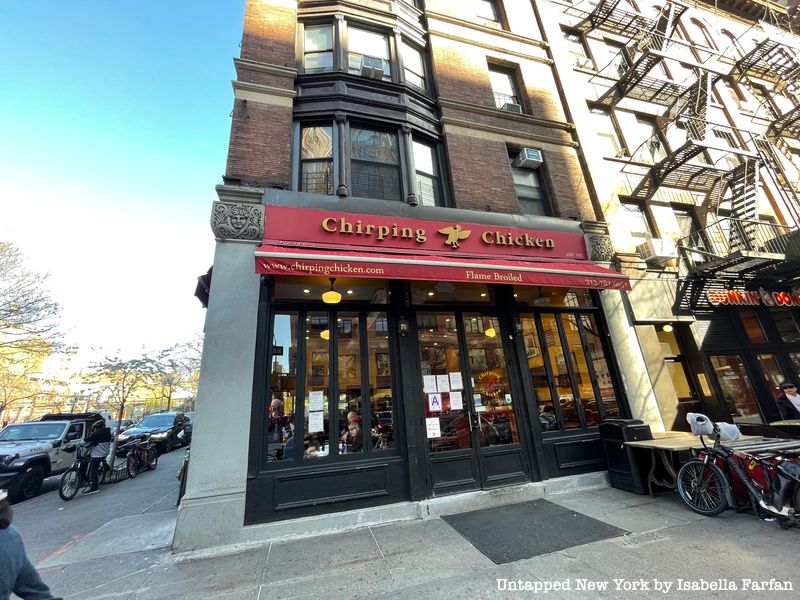10 Giant Menorahs That Will Light Up for Hanukkah in NYC
From Brooklyn to the Bronx, we’ve rounded up the most exciting giant menorahs that will light up throughout the next eight evenings!



Smoked sturgeon and shish kebab are among the oldest dishes being served between West 59th and 110th Streets. From arson, kitchen catastrophes, movie stars, and lucky lottery numbers, the eatery holdouts of the Upper West Side embody unique tales of a past and present Upper West Side. The Upper West Side attracts intellectuals and creatives alike with its famed Lincoln Center and spillover of Columbia University affiliates near West 110th Street. As the neighborhood has become increasingly desirable for wealthy young people, an aggressive battle for development has ensued.
The neighborhood was historically home to Jewish, Irish, and Caribbean immigrants, as well as African Americans who lived in the former San Juan Hill neighborhood that was demolished to make Lincoln Center. Pandemic-related difficulties and the ever-increasing cost of rent in the area have unfortunately led to the demise of some long-standing, local neighborhood restaurants, like La Caridad 78. Some flavors of an older Upper West Side still remain though, in the form of a few persistent holdouts. Here are seven of the oldest restaurants on the Upper West Side with dine-in options.

Between W 86th and W 87th streets on Amsterdam Avenue, the legacy of “The Sturgeon King” remains intact. Barney Greengrass originally opened his appetizing store in Harlem in 1908 and relocated it to Amsterdam Avenue in 1929. In 1938, Barney Greengrass expanded to include a restaurant. Now, Barney Greengrass’ grandson Gary Greengrass oversees the restaurant, continuing the family’s 110-year-old management. The restaurant and deli specialize in smoked sturgeon and other smoked fish.
In 1939, Barney Greengrass received an order from President Franklin Delano Roosevelt who wanted sturgeon shipped to him in Georgia. According to Gary Greengrass, the nickname “The Sturgeon King,” came from Franklin Delano Roosevelt’s speechwriter Sam Rosenman. The establishment also appears as an Upper West Side classic in 30 Rock, Revolutionary Road, and Extremely Loud And Incredibly Close.
Barney Greengrass has survived its fair share of setbacks including a temporary shut down due to a health violation, pandemic closures, and a recent arson. According to Zagat, the Barney Greengrass’ strong reputation for selling to-go items and shipping its sturgeon helped it stay afloat during the pandemic.

Old John’s Diner, formerly Old John’s Luncheonette, serves up comfort food in a family-like atmosphere. Old John’s Luncheonette, dating back to the 1950s, was set to close permanently as a result of COVID-19 lockdowns. However, former Old John’s delivery worker and current restauranteur Louis Skibar took over ownership of restaurant, allowing the diner to stay open at its original location on West 67th Street despite widespread shuttering of diners across New York City due to rising rents.
When word of a closure first reached patrons, they reacted with action. Regular customers created a GoFundMe when the restaurant first gave indications that it might cease operations. Molly Sherb, the organizer of the fundraiser, likened the luncheonette to “a historical landmark of the Upper West Side” writing, “I, along with many others, have formed connections and friendships with the employees over the years and in many ways they have come to feel like family.” The GoFundMe raised $8,710, but it was not enough to keep the luncheonette open. When Skibar took over, he revamped the space and the menu, but maintained the luncheonette’s classic features including its original egg cream.

Since Broadway Restaurant opened in 1970 at 2664 Broadway, the Arsenis family has cultivated a loyal following with bargain prices, and charming owners and staff. Over forty years ago, cousins Chris and Angelo Arsenis purchased the joint, while another one of their cousins, Tony, began working at the cash register. Customers and the Arsenis family alike point to an intimate ambiance as a main reason Broadway Restaurant has charmed for decades.
The menu incorporates classic diner items, like their $7.50 standard burger, but also pays homage to the family’s Greek heritage with dishes like their Feta Cheeseburger and Gyros. The walls are also occupied by images of Marilyn Monroe and Sophia Loren, among others, reminiscent of a bygone era. On New Year’s day in 2018, Broadway Restaurant suffered a fire that destroyed its kitchen, forcing the restaurant to close for six months. By the end of June 2018, the restaurant was back open, with the same service, food, and even the same seat cushions as before.

In 1973, Nicholas Gray, former employee of Papaya King, opened the original Gray’s Papaya on Broadway and West 72nd Street. Once a mini-chain, the joint now only operates at its flagship location. It dwindled down to only its flagship store after its other locations closed due to rent hikes. Gray’s Papaya serves beef franks notable for their snapping bite, thanks to the use of sheep intestine, and tropical drinks in various flavors. The name “Gray’s Papaya” comes from the owner’s surname and from the tropical beverages on the menu. In bold red lettering the catchphrase “when you’re hungry, or broke, or just in a hurry” faces passersby. This slogan is not an empty promise.
The joint offers a “Recession Special” consisting of two hot dogs and a drink for a discounted price. The price of the specials have varied over the years. In the ‘90’s the “Recession Special” was only $1.95, while during the 2008 financial crisis the special cost $4.45. Today, the special costs $6.95. The “Recession Special” reflects a deep sympathy Gray has for his customers. Each time he raises a price, he expresses deep reluctance in doing so. In 2008, Gray told the New York Times that raising the prices is “very traumatic” for not only his customers but also for him.

On Broadway between West 103rd and 104th streets, Jerusalem Restaurant has offered Middle Eastern, Mediterranean, and halal food since 1979. The restaurant boasts “famous” pita and hummus, quick delivery times, and an extensive vegetarian menu with fourteen dishes. Jerusalem Restaurant also proudly states that it has served “residents with quality food for years.”
The exterior has a modest patio occupied by a single table and potted plants. Inside the restaurant, a couple of tables sit right next to where food is prepared. A splayed menu sits in front of the patio, offering 16 Middle Eastern specialties that can be ordered as sandwiches or as platters starting at $5.95, all with halal meat.

Although Chirping Chicken now has six locations across New York City, it originates from its Amsterdam Avenue location between 76th and 77th Streets. Founded in 1982, the local chain specializes in “charcoal-broiled birds.” Chirping Chicken is currently owned by a man known by his first name “Stelios,” who credits his Greek heritage for the popular charcoal-broiled chicken. Aside from its tender, complexly seasoned chicken and other comfort foods, the Chirping Chicken name is also famous for a different reason.
In November 1996, Niki Barkoutis, the daughter of original co-owner Louis Barkoutsis, frequently worked behind the counter at her father’s restaurant on the Upper West Side. Barkoutsis was working at the family’s Amsterdam Avenue location when she decided to purchase a lottery ticket. Her lottery ticket was the winning ticket and she won part of a $45 million dollar lottery prize at only 23 years old. Niki Barkoutsis was set on using her fortune to help Chirping Chicken expand nationally. This dream, though, was not realized. The chain remains exclusive to New York City. The restaurants’ six locations continually garner positive reviews, with a menu including classically Greek dishes and also non-Greek dishes like Arroz Con Pollo.

Cafe Luxembourg on 200 West 70th Street serves zucchini fries with a Yuzu-garlic aoili alongside other ingenious dishes. The cafe was opened as a French bistro in 1983 by husband-wife restauranteur duo Lynn Wagennecht and Keith McNally after finding success in their earlier downtown restaurant ventures Odeon and Cafe Cluny. On most of the restaurant’s merchandise, including their gift cards and towels, a black and white photograph of three naked Parisian women occupies the focal point. The iconic photograph was taken by Brassaï, a street photographer famous for capturing Parisian nightlife in the early 1930’s.
Cafe Luxembourg describes its atmosphere as “Art Deco,” a movement in decorative art emerging out of Paris in the mid 1920’s. Art Deco plays on elegance and traditionalism by giving life practical objects with artistic flare. The restaurant honors this design tradition with elegant Jean Perzel lighting fixtures throughout the restaurant. The carefully curated design of the restaurant sets up an elegant backdrop for breakfast, lunch, and dinner as it does in the 1989 filmWhen Harry Met Sally as the site for a very awkward double-date between Harry, Sally, and two of their friends.
Next, check out 15 of the oldest restaurants in New York City.
Subscribe to our newsletter